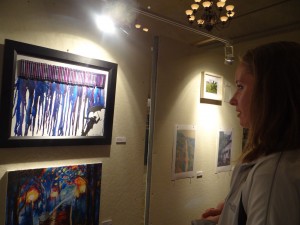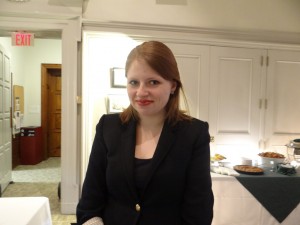On Sunday, March 23, students gathered in Laughlin living room for an intimate evening of storytelling and pizza hosted by the Laughlin Intercultural Living Learning Community.
Temujin Ekunfeo, a professional storyteller, instrument maker, historian, and anthropologist, began his career telling stories in 1968 at age 17.
Ekunfeo’s ancestry–with a paternal grandfather born into slavery and a maternal grandfather brought “in chains” to the United States–sparked his interest in preserving and passing down African culture.
At age 17, Ekunfeo began dressing in traditional African clothing native to the Yoruba people from whom he descends. On Sunday evening, he wore Yoruba dress clothes, as well as many pounds of necklaces bearing hippopotamus teeth, warthog tusks, copal (a resin similar to amber), and beads.
“When I’m done, I take these off and I grow about six inches,” he said about the heavy jewelry.
As a teenager, Ekunfeo was a shy poet. With time, reciting his poetry allowed him to break out of his shell and transition into the art of storytelling.
Despite his interest in his heritage and African culture, Ekunfeo tells stories from all over the world. His only rule is that he will only tell a story if he likes it.
“If I like a story, I only need to hear it one time, and it’s up there forever,” he said, gesturing to his head.
Every story Ekunfeo tells is “a most favorite story.” He avoids telling Shel Silverstein’s “The Giving Tree”, for example, because he thinks the main character is a “jerk” for taking so much from the Giving Tree without ever saying ‘thank you.’
Ekunfeo also avoids stories with blatant messages. “If you want to be preached at, go to church,” he said.
He is unable to tell a few stories because he loves them so much. For example, a story about a blind princess who learns to “see with her hands” is so beautiful that it causes him to weep, and he cannot finish it.
In addition to being a storyteller, Ekunfeo also makes drums. He brought a drum handcrafted from part of a hollow tapered wooden column he bought at Construction Junction.
He demonstrated the three sounds that a drum can make: bass (a lower resonating sound), tone (a higher resonating sound), and slap (a short sound). According to Ekunfeo, drum music has to contain at least two of these sounds to be considered music.
“I could bang on that piano all day and not be invited to Carnegie Hall, but if I play this [drum] like I’m supposed to, I [could be and] have been invited to Carnegie Hall,” he said.
Upon a request from first-year Tahmina Tursonzadah for a scary story, Ekunfeo began his story telling with “The Monkey’s Paw,” a tale about a mother’s wishes gone terribly wrong.
Although the story was spooky, Ekunfeo said he does not tell ghost stories because “the premise around them is sad” since ghosts are trapped between the worlds of the living and the dead.
He then told a story that is originally from southern folklore. With his overemphasized local accent and the relocation of the setting to the bank of the Allegheny River, Ekunfeo gave the story (about a man being terrorized by the animal from which his dinner had come) a more local context.
The last story Ekunfeo told was the first one he ever heard. He first heard it at age seven. In this story, a king orders his subjects to find him the most unique and valuable object the world can offer. After many disappointing gifts, a girl presents herself–a unique human being with much to offer–to the king, and from then on, she rules beside him.
Although he generally dislikes preaching in his stories, Ekunfeo thinks the message in this story is worth circulating–that each individual has worth.
“You stand on the brink of the future. I’ve managed to take something I never thought could be a career, and turn it into a career,” he said. “Learn everything you can, and don’t be afraid to take a chance.”
Students appreciated Ekunfeo’s loud and energetic storytelling style. “I thought at first it was going to be annoying with his exuberant personality, but it turned out to be very engaging,” first-year Abigail Beckwith said.
Tursonzadah agreed. “I’ve never heard a story the way he told it. It was very compelling,” she said.






